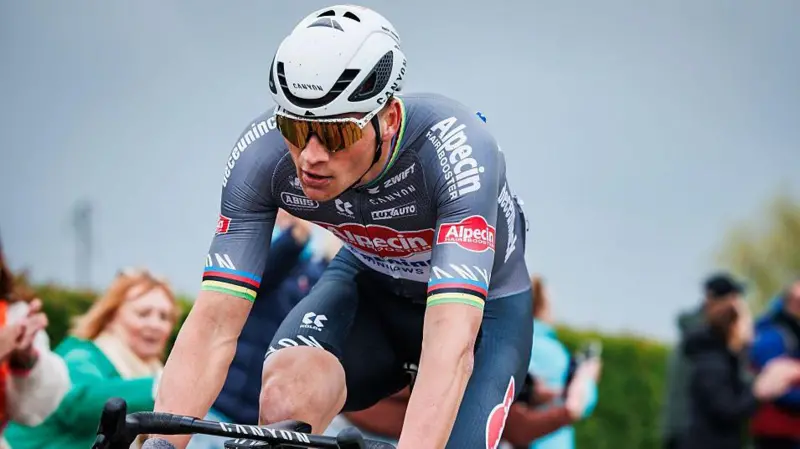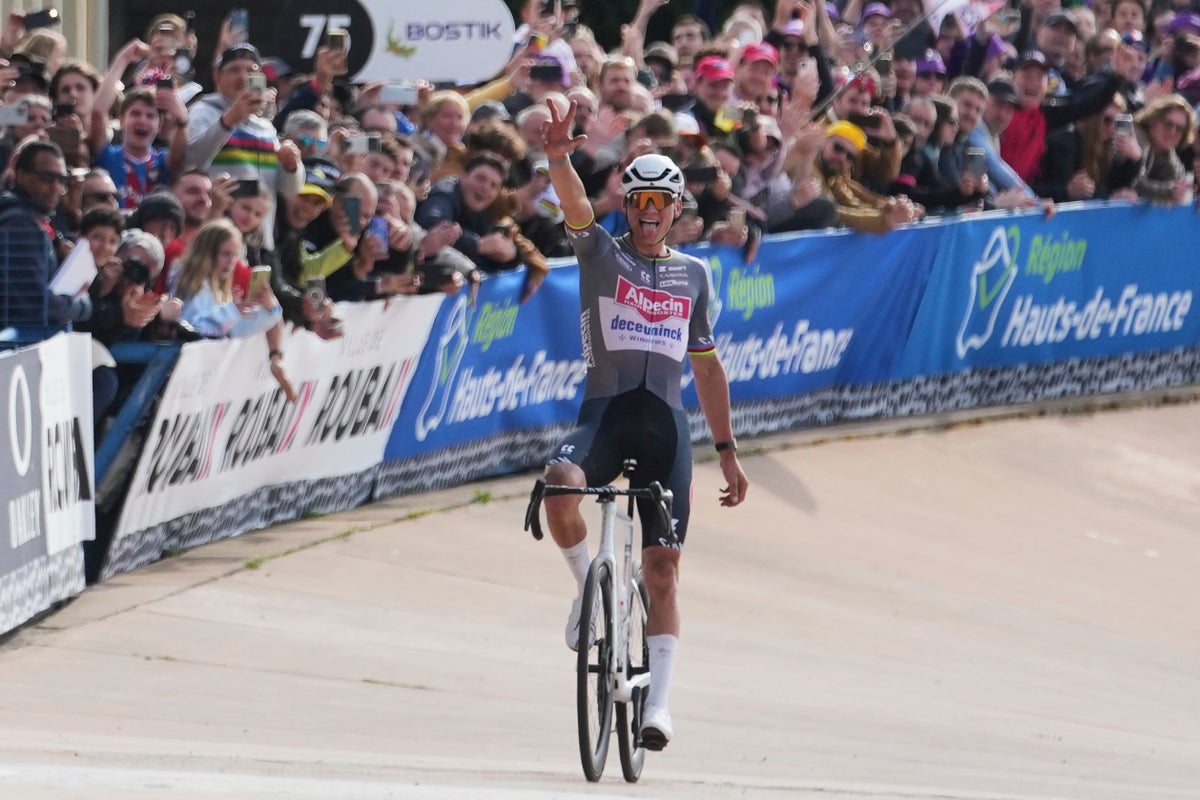
Van der Poel Struck by Bottle in Paris-Roubaix Chaos as Man Hands Himself In
Man hands himself in after bottle hits Van der Poel during iconic one-day classic
Paris-Roubaix is known for its bone-rattling cobblestones, dramatic attacks, and timeless glory—but this year’s edition will also be remembered for an unfortunate and dangerous moment involving one of the sport’s biggest stars. Dutch cycling sensation Mathieu van der Poel was struck in the face by a bottle hurled from the crowd while powering towards victory on the brutal pavé, raising serious questions about rider safety and fan behavior in professional cycling.
As the 30-year-old was storming through one of the narrow, dust-choked cobbled sections with just 23 miles left to race, a nearly full water bottle came flying out of the roadside throng and smacked him on the cheek. The reigning Paris-Roubaix champion, riding solo at the front in his signature all-black Alpecin–Deceuninck kit, flinched but stayed upright, grinding on without hesitation. His response, as ever, was defiant—he didn’t just recover, he won the race by over a minute, sealing a record-equalling third consecutive Roubaix triumph.
But the incident cast a shadow over what should have been a day of celebration.
Suspect Turns Himself In to Belgian Police
A day after the race, police in Belgium confirmed that a man had handed himself in to a station in West Flanders, admitting to being the person who threw the bottle. The suspect’s name has not been made public, but Belgian public prosecutor Filiep Jodts told BBC Sport that a statement had been recorded and an official report had been drawn up.
“The Public Prosecution Service will decide in the coming days what action should be taken,” Jodts said, suggesting that legal consequences could follow.
It’s a rare case of accountability in a sport where spectator interference, although condemned, often goes unpunished. For Van der Poel, who has been at the center of several fan-related incidents over the years, this latest episode has only reinforced his calls for more to be done.
“It Felt Like Getting Hit by a Stone”

Paris-Roubaix spectator who threw bottle at Mathieu van der Poel hands himself in to police
Speaking to reporters after his eighth career Monument win, Van der Poel didn’t downplay the severity of the hit.
“The bottle was nearly full and weighed half a kilo,” he said. “When someone throws it like that, it’s not nothing. It felt like getting hit by a stone.”
Video footage showed him reaching instinctively for his cheek in pain but never faltering on the bike. There was no theatrical protest, no look back at the crowd. In true Van der Poel fashion, he pushed through, eyes locked on the cobbles ahead.
But while his resilience remains unmatched, the question lingers: how many more of these incidents must riders endure before serious changes are made?
A Disturbing Pattern for Van der Poel
Unfortunately, this wasn’t the first time Van der Poel has found himself at the receiving end of unsporting behavior from spectators.
Back in December 2023, during a cyclocross race in the Netherlands, he made headlines for spitting toward fans after being jeered and having liquid thrown at him. The following spring, he was again the target—this time doused in beer at the Tour of Flanders.
Just last month, at the E3 Saxo Classic in Belgium, Van der Poel reported being spat at once more.
“Something should be done about it,” he urged on Sunday. “People spitting and throwing things—it’s too much. I’m going to ask for action to be taken.”
The Demands of Paris-Roubaix and Its Massive Crowds
Paris-Roubaix is one of cycling’s true institutions. Known as “The Hell of the North,” it’s a 259.2-kilometer test of endurance, skill, and toughness. Roughly 50 kilometers of the course are cobbled, including infamous sectors like the Arenberg Forest and Carrefour de l’Arbre, which are lined by thousands of spectators squeezing onto narrow verges for a glimpse of the action.
The race’s unique atmosphere is part of its charm—but also part of the risk.
It’s estimated that up to half a million fans line the route, most without any form of barrier separating them from the riders. The opportunity for interference—intentional or accidental—is constant.
While cycling has always prided itself on its accessibility and intimacy between fans and riders, high-profile incidents like Sunday’s bottle throw are forcing the sport to reevaluate that balance.
A Monumental Victory Overshadowed
Van der Poel’s third consecutive Paris-Roubaix title put him alongside legends who’ve won three editions in a row—a feat last achieved by Francesco Moser between 1978 and 1980. It also took his tally of Monument victories to eight, matching his rival Tadej Pogačar.
But instead of being the sole focus, Van der Poel’s achievement was partly eclipsed by the incident.
“It’s a shame we’re talking about this,” said Belgian cycling analyst Karl Vannieuwkerke. “This should have been about Mathieu writing more history.”
Even as he stood atop the famous Roubaix podium in the iconic velodrome, the bruise on his cheek and the reminder of what had happened were impossible to ignore.
A Sport Under Pressure to Act
Professional cycling has seen a growing number of incidents involving fans in recent years, particularly since the return of mass crowds post-pandemic.
From Tour de France crashes caused by selfie-taking spectators to the infamous 2021 incident involving a cardboard sign that led to a mass pile-up, the risks have become more visible—and more dangerous.
The UCI, cycling’s global governing body, has made gestures toward improving safety, but Van der Poel and other riders have voiced frustration at the lack of meaningful change.
“This can’t keep happening,” he said. “We need better security, more awareness, and real consequences.”
A Wake-Up Call for Race Organisers?
The Amaury Sport Organisation (ASO), which runs both Paris-Roubaix and the Tour de France, has long embraced the wild, unfiltered spirit of road racing. But pressure is mounting for them to act more decisively.
Calls have been made for greater security in high-risk areas, more barriers on narrow sections, and clearer messaging to fans about behavior.
“It’s not about removing the soul of cycling,” said former rider Jens Voigt. “It’s about keeping riders safe so they can perform without fear.”
Whether this latest incident leads to tangible changes remains to be seen—but Van der Poel’s case may be the tipping point.
Van der Poel: Still Standing, Still Winning
Despite it all, Mathieu van der Poel showed once again why he’s one of the toughest and most captivating athletes in modern sport. He didn’t let a half-kilo projectile derail his race or his resolve. He conquered the cobbles with power, grace, and an unshakable mindset.
But his victory speech was as much a plea as it was a celebration.
“I love this sport,” he said. “But I want it to be better—for me, and for the next generation of riders.”
Van der Poel may have won Paris-Roubaix again. But it’s clear that for him—and for cycling as a whole—the real victory will be when no rider has to fear the fans lining the road.
































There are no comments yet. Be the first to comment!